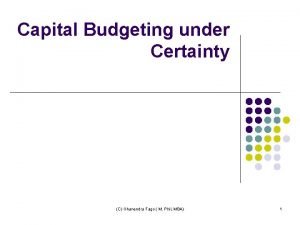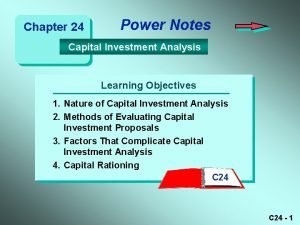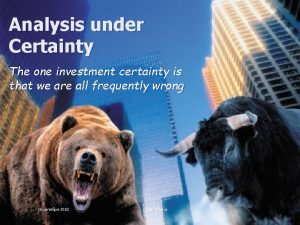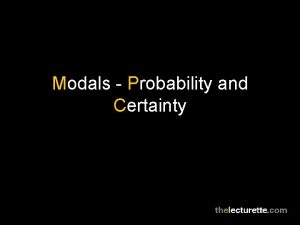Analysis under Certainty The one investment certainty is















- Slides: 15

Analysis under Certainty The one investment certainty is that we are all frequently wrong 26 октября 2002 Стратегии

Up to now n Financial markets and instruments – Specifics of stocks, bonds, and derivatives – Trading process – Financial intermediaries NES FF 2005/06 2

Plan n Analysis under certainty – Term structure of interest rates – Fixed income instruments • • Pricing Risks – Capital budgeting NES FF 2005/06 3

Definitions of rates n Reinvestment: – Simple vs compound interest n Frequency of compounding: – Nominal (coupon) rate vs effective (annual) rate n Continuous compounding: – Log-return NES FF 2005/06 4

Definitions of rates (2) n Yield to maturity / internal yield / bond yield – Rate that equates cash flows on the bond with its market value – Return earned from holding a bond to maturity • n Assuming reinvestment at same rate Par yield – Coupon rate that causes the bond price to equal its face value n Current yield – Annual coupon payment divided by the bond’s price – Often quoted but useless FF 2005/06 NES 5

Definitions of rates (3) n Zero rate – – – n YTM of a zero-coupon bond How to get zero rates from coupon bond prices? Bootstrapping method: coupon bond as a ptf of zerocoupon bonds Spot rate – One-period zero rate n Forward rate – Rate on a one-period credit from T to T+1 FF 2005/06 NES 6

Term structure of interest rates n Relationship between yields and maturities – For bonds of a uniform quality (risks and taxes) – E. g. , Treasury / Baa n Equivalent ways to describe TSIR: – Prices of zero-coupon bonds: P(t, T), with P(T, T)=1 – Zero rates: y(t, T) – Forward rates: f(t, T) n Upward sloping yield curve: – Fwd Rate > Zero Rate > Par Yield NES FF 2005/06 7

Theories of the term structure n Expectations theory: – Unbiased expectations hypothesis: f(t, T) = Et[r(T)] – Term structure is explained by expected spot rates • n Upward sloping yield curve: signal that spot rate will increase Liquidity preference theory: – Investors demand a premium for bonds with higher risk • Long-term bonds require a liquidity premium – Upward sloping yield curve: forward rates higher than expected future zero rates NES FF 2005/06 8

Theories of the term structure (2) n Preferred habitat: – Investors try to match the life of their assets with liabilities – There is a premium for maturities with insufficient demand n Market segmentation: – Different rates determined independently of each other • • SR%: D – corporations financing sr obligations, S – banks LR%: D – corporations financing lr inv projects, S – insurance co-s, pension funds – Investors don’t react to yield differentials between the NES maturities FF 2005/06 9

Empirical estimation of TSIR n Discrete rates: – Regression n P = c. D 1 + c. D 2 + … + (c+F)DT where Dt = 1/P(0, t) = 1/y(0, t)t Continuous rates: – Regression P = Σt=1: T ct (a 0+a 1 t+a 2 t 2+…) – P = a 0[Σt=1: Tct]+a 1[Σt=1: Ttct]+a 2[Σt=1: Tt 2 ct]+… NES FF 2005/06 10

Modeling changes in bond prices n Due to passage of time: – E. g. , flat yield curve: ΔP = r P 0 n Unanticipated shift in the TSIR: – Need to approximate the function P = f(y) – Duration: sensitivity of a bond’s price to the change in the interest rates NES FF 2005/06 11

Macaulay’s duration n Wtd-avg maturity of bond payments – Generalized maturity for coupon bonds, D ≤ T n Elasticity of a bond’s price wrt ytm – The larger the duration, the riskier is the bond n For small changes in %: ΔP ≈ -D P Δy/y = -[D/y] P Δy – D* = D/y: modified duration NES FF 2005/06 12

Macaulay’s duration (2) n Properties: – C, coupon: – – Y, %: – – T, maturity: + n Limitations: – Assumes horizontal TSIR – Applies only to small changes in % NES FF 2005/06 13

Duration modifications Convexity n Fisher-Weil duration n n – For parallel shifts of (non-horizontal) TSIR Non-parallel shifts: – Two types: LR% usually more stable than SR% – Analytical approach: • E. g. , assume d ln y(t, T) = KT-t+1 d ln r(t) – Empirical approach: • Separate estimation of duration for sr and lr % NES FF 2005/06 14

Conclusions 26 октября 2002 Стратегии
 Straight line method of depreciation
Straight line method of depreciation Fixed investment and inventory investment
Fixed investment and inventory investment One god one empire one religion
One god one empire one religion One one little dog run
One one little dog run One king one law one faith
One king one law one faith One empire one god one emperor
One empire one god one emperor One team one plan one goal
One team one plan one goal See one do one teach one
See one do one teach one One price policy
One price policy Twelfth night speeches
Twelfth night speeches Studiendekanat uni bonn
Studiendekanat uni bonn One vision one identity one community
One vision one identity one community Graphic organizer with the aims of la liga filipina
Graphic organizer with the aims of la liga filipina Othello setting act 1
Othello setting act 1 Real estate financial analysis
Real estate financial analysis Factors that complicate capital investment analysis
Factors that complicate capital investment analysis





























